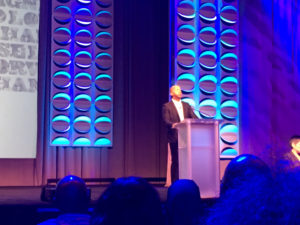
Bryan Stevenson, the executive director of the Equal Justice Initiative, spoke this morning. If you haven’t read his book, Just Mercy, fire up your Amazon app right now. I’m not sure there was anyone near me who wasn’t crying, with tears shifting from tears of empathy, to tears of rage, to tears of beauty and hope. With an amazing mix of clear-eyed reality and inspiring hope, Bryan offered sobering and cruel statistics about incarceration rates for people of color, enraging stories of his experience advocating for unjustly incarcerated adults and children, and, finally, a path toward justice. He offered four values we must embody if we are to change this world: Proximity to those who are wronged, Changing the Narratives of race and otherness that justify oppression, remaining Hopeful, and lastly, being willing to do profoundly Uncomfortable Things.
About Proximity he observed that it is critical for us to be in direct human contact with the people affected by the cultural wrongs we seek to remedy if we hope to effect change. And he offered as encouragement, “You don’t have to have the answers to get proximate, you just have to get there. There is power in proximity.” As independent schools grapple with the complexity of inclusivity and belonging, I wonder what we define as “getting there,” what we aspire to be proximate to? I wonder if we are defining Proximity as simply proximity to the visual aspects of diversity, rather than proximity to injustice? The school where I work and where my son goes is by most measures a diverse and inclusive community, with a high percentage of students and faculty of color, many religious viewpoints, and is a safe place for same sex couples and their children. To wit, my son has only ever known a person of color as the top leader of his school, he sees himself in many of his teachers, and his view of the niqab, which one of his Muslim teachers wears, is that it is simply one of the possible articles of clothing that someone might wear. But we, like most independent schools, are insular and those of us who identify as white may fall too easily into the trap of thinking all is well, since it seems so within the walls of the school, and little about our experiences outside of school challenges that notion. So our version of Proximity is an artificial one. The Muslim colleague I mentioned was called a terrorist a block from the school and threatened by a group of men. My African-American colleagues are pulled over by police and scrutinized in stores. They live outside of our insular bubble every day in a way that my white colleagues and I do not.
What would it look like for independent schools to truly “get there,” to seek proximity to injustice, to connect with disenfranchised communities in relationship, partnership and engagement to solve problems that affect us all (whether we recognized it or not)? This almost certainly can’t be done within the walls of the school. It requires a vision that pushes our sometimes-insular school communities beyond their walls and into the broader community to connect with the amazing diversity that exists in every city, engages in the issues that affect all citizens, understands each other’s stories, all ultimately to create a generation of informed, engaged citizens who know that our collective diversity and varied experiences are powerful assets. As we examine ourselves as schools, knowing that many of our institutions were established explicitly to shield our children from the world outside of the insular walls, let’s ask ourselves which direction will best prepare our children with skills, compassion, empathy, and sense of interdependence to lead in a multicultural world.
Allen Broyles @allenbroyles









